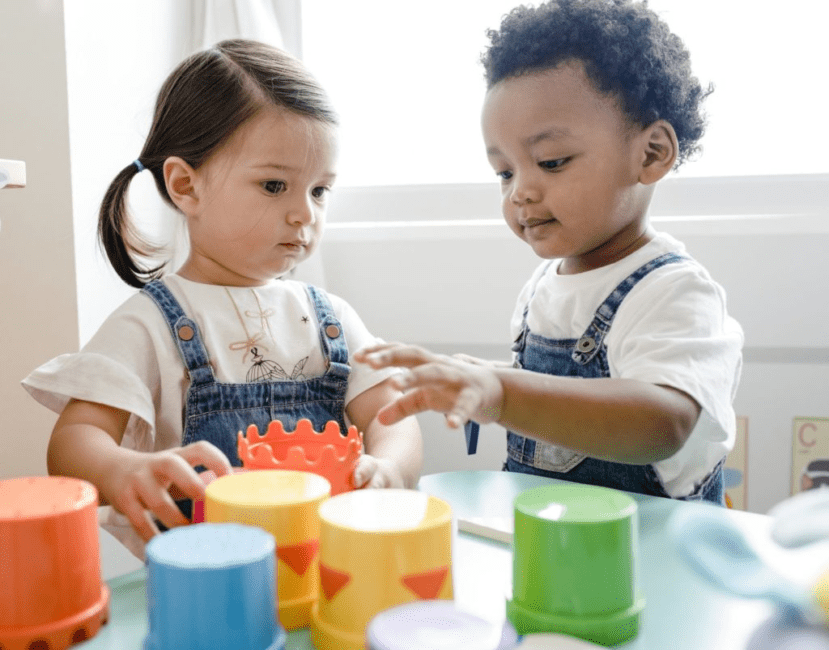The preschool program is expected to cover a wide range of experiences and activities, such as looking after physical needs such as feeding, toileting, and rest; satisfying the emotional need for warmth, love, and affection, and meeting the need for exposure to stimulating experiences.
In such a setting, most of the teaching is done indirectly and through non-formal methods. The resourceful caregiver or teacher creates a place for learning by providing as many instructional materials and actual experiences as possible.
In this unit, therefore, we shall be discussing the activities that can be considered vital to the child’s total development, bearing in mind that no activity promotes only one kind of development. For proper development preschool activities should focus on enriching all aspects of children’s experiences.
Read Also: Definition of Growth and Development of Preschool Child
Day-Care Learning Activities (Preschool Program)

Visual Experiences
A child absorbs knowledge through the use of the senses. Visual experiences refer to the knowledge or observation of facts gained using the eye senses. Colorful mobiles of cardboard and glass paper, small tins or reels, or small, stuffed cloth figures can be hung.
The child should be propped up so that he can see around him instead of continuously gazing at the ceiling. Let his eyes follow objectives such as rattle, toy, or even the caregiver’s hand. A four or five months old child should be given big, colorful, pictures and toys.
Read Also: Trends in Growth and Development of the Preschool Child
Auditory Experiences
The child also learns and gains knowledge about the world around him through the use of his ears i.e. organs for hearing or the auditory senses. The caregiver should talk to the child as he is fed, changed, or played with; play soft music most normal children respond to music.
The caregiver should sing and provide him with rattles, bells, squeaky toys, etc., which will expose him to different sounds. As the baby grows older, recite simple nursery rhymes with actions, name familiar objects, and body parts, and read aloud simple stories from picture books.
Physical Exercise
The caregiver must bear in mind that the child needs so much to exercise the whole of his body. Therefore, the child must be allowed to kick freely; do not bundle or tie up his arm and legs in a sheet, as this will restrict his movement.
Exercise his arms and legs by raising them and bending them while making it an enjoyable experience by talking to him and smiling at him. As the child begins to crawl, provide him with sufficient space.
Remove sharp and dangerous objects around. Tape any plug point which may be reachable. Remove breakable objects and put a railing along the verandah to make sure that the child does not stray outside or fall down the stairs. Provide him with plastic balls that he can play with. As the child learns to walk, provide him with pull-along toys.
Read Also: Definition and Different Kinds of Learning
Language Experiences
Although at this stage, the child is unable to use language in the real sense, he must be exposed to as many language experiences as possible. The infant should be spoken to, and read to, even though he cannot respond.
Manipulative and Tactile Experiences
A wide variety of toys and objects should be provided to encourage the child to hold, grasp and bang. Rattles, old plastic spoons, small pans which do not have sharp edges, squeaky toys, and toys with moveable parts and blocks should be provided.
The toys should not be too large or small; they should be big enough for the child to grasp. Old newspapers are a popular item that children gleefully pull, tear and thrash around.
Playing with water is also a joyful experience and the children become familiar with the feel of water. Big crayons can also be given for scribbling on paper.
Social Experiences
The essence of early childhood education is to give children a loving and responsive environment with adults encouraging and supporting them.
The absence of strong, affectionate, and caring relationships may retard children’s curiosity and consequently lead to intellectual, social and emotional problems (Osanyin, 2002)
Read Also: The Environment in Early Childhood Education
This is a crucial stage for forming relationships. The caregiver should be ready to regularly hold the child, tickle him, talk to him and play simple games.
The child should be called by his name and exposed with care to others in the environment. The child should be encouraged to interact with adults and peers in his environment.
In conclusion, the task of providing a developmentally appropriate environment for the infant requires careful recognition on the part of the teacher, of the various aspects of experience that the child can be exposed to.
In Day Care Centres, teaching is mostly done indirectly and through non-formal methods. Activities that promote development may be classified into social, emotional, physical, and cognitive.
Each activity promotes more than one kind of development. For proper development to take place, preschool activities should focus on enriching all aspects of children’s experiences. A child absorbs knowledge through the use of his or her senses of touch, eyes, and ears.
Read Also: Planning the Learning Environment
